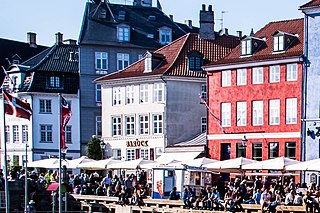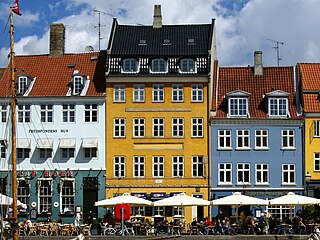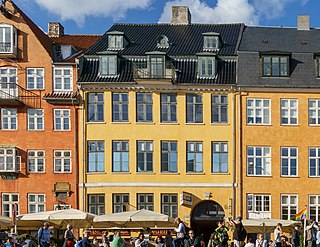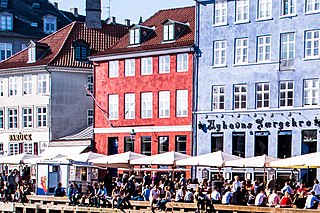
Nyhavn 1 is an 18th-century property at the acute corner of Nyhavn with Store Strandstræde in central Copenhagen, Denmark. It was listed in the Danish registry of protected buildings and places in 1987. Notable former residents include actor and singer Peter Schram (1819–1895).

Nyhavn 11 is an 18th-century property overlooking the Nyhavn canal in central Copenhagen, Denmark. Ludvig Ferdinand Rømer established a sugar refinery on the property in 1653 and it was later continued by changing owners until at least the 1860s. A small figure of a sugar-baker holding a sugar cone is still seen above the gate. The building was listed in the Danish registry of protected buildings and places in 1932. Notable former residents include the general trader Jacob Severin and actors Christen Niemann Rosenkilde, Julie Sødring and Poul Reumert. The lamp manufacturer Louis Poulsen was later based in the building from 1908 to 2006.

Nyhavn 18 is a listed property overlooking the Nyhavn canal in central Copenhagen, Denmark. The writer Hans Christian Andersen lived on the first floor from 1871 until shortly before his death on 4 August 1875. The building has now been converted into residences for visiting guest artists and scientists.

Nyhavn 67 is a listed property overlooking the Nyhavn Canal in central Copenhagen, Denmark. The writer Hans Christian Andersen lived in the building as a lodger with only short interruptions from 1848 to 1865.

Nyhavn 13 is a historic townhouse overlooking the Nyhavn Canal in central Copenhagen, Denmark. With roots dating back to the late 17th century, it owes its current appearance to a heightening of the building with two floors in 1842. Notable former residents include the businessman Abraham Marcus Hirschsprung and the painter and educator Wilhelm Kyhn. The building was listed in the Danish registry of protected buildings and places in 1945.

Nyhavn 23 is a Neoclassical property overlooking the Nyhavn Canal in central Copenhagen, Denmark. It was listed in the Danish registry of protected buildings and places in 1918. A plaque on the facade commemorates the composer Friedrich Kuhlau, who resided there in 1832.

Nyhavn 41 is a listed property overlooking the Nyhavn canal in central Copenhagen, Denmark. For most of the 19th century, the property was owned by a family of sailmakers. The manufacturing of flags and compasses was also part of their trade. The building was listed in the Danish registry of protected buildings and places in 1918.

Nyhavn 43 is a historic townhouse overlooking the Nyhavn Canal in central Copenhagen, Denmark. The building was listed on the Danish registry of protected buildings and places in 1945. It was refurbished in 1987.

Nyhavn 19 is a property located at the corner of Nyhavn and Lille Strandstræde in central Copenhagen, Denmark. The building was listed on the Danish registry of protected buildings and places.

Lille Strandstræde 10 is an 18th-century property situated in the Nyhavn Quarter of central Copenhagen, Denmark. It was listed in the Danish registry of protected buildings and places in 1988.

Nyhavn 47 is an 18th-century property situated at the corner of Nyhavn and Toldbodgade in central Copenhagen, Denmark. It owes its current appearance to a renovation undertaken by Julius Andreas Blom in 1842–45. It was listed in the Danish registry of protected buildings and places in 1932. Notable former residents include the merchant and shipowner Peter Christian Knudtzon.

Nyhavn 45 is an 18th-century property overlooking the Nyhavn Canal in central Copenhagen, Denmark. It was listed in the Danish registry of protected buildings and places in 1945.

Nyhavn 3 is an 18th-century property overlooking the Nyhavn Canal in central Copenhagen, Denmark. It was listed in the Danish registry of protected buildings and places in 1945.

Lille Strandstræde 8 is an 18th-century property situated around the corner from Nyhavn in central Copenhagen, Denmark. Constructed as a two-storey, half-timbered building for Andreas Bodenhoff in the middle of the century, it was later first reconstructed in brick and heightened with two storeys in 1783 and then, in 1932, expanded with a seven-bays-long side wing on the rear. The building was listed in the Danish registry of protected buildings and places in 1959. Notable former residents include the German painter Bernhard Mohrhagen and the veterinarian Viggo Stockfleth.

Nyhavn 53, also known as Madame Tofte's House, is a residential building overlooking the Nyhavn canal in central Copenhagen, Denmark. It was constructed with three storeys in the 1750s but owes its current appearance to a renovation in the 1870s. It was listed in the Danish registry of protected buildings and places in 1932. Notable former residents include the composer Peter Arnold Heise and the ballet dancer Augusta Nielsen. The Adventurers' Club of Denmark is based in a half-timbered warehouse in the courtyard.

Nyhavn 61 is an 18th-century residential building overlooking the Nyhavn canal in central Copenhagen, Denmark. The building was listed in the Danish registry of protected buildings and places in 1945. The scope of the heritage listing was expanded in 1984. Nyhavn 61 and Nyhavn 59 have now been merged into a single property and are physically integrated on the third floor. The two buildings share a central courtyard.

Nyhavn 21/Lille Strandstræde 4, formerly known as Hotel L'ven, Hotel Kronprinsen and Fredsfondens Hus, is a complex of historic buildings overlooking the Nyhavn canal in central Copenhagen, Denmark. It consists of a late 17th-century building in Nyhavn and a just two bays wide building in Lille Strandstræde as well as a two-storey rear wing from 1748. It was listed in the Danish registry of protected buildings and places in 1945. The restaurant Cap Horn was a popular jazz venue in the 1950s. It is now part of the Tholstrup restaurant group. Notable former residents include the politician Jens Christian Christensen and painters Anna and Michael Ancher.

Pilestræde 42 is an 18th-century building situated in Pilestræde in the Old Town of Copenhagen, Denmark. Originally a two-storey building from the 1730s, constructed on the foundations of Christian IV's Canon Foundry, it was later in the century heightened with two storeys. Pilestræde 42 and Pilestræde 44 were merged into a single property in the early 1970s. The two buildings were listed in the Danish registry of protected buildings and places in 1985.

Nyhavn 17 is a late 17th-century building situated at the corner of Nyhavn and Lille Strandstræde in central Copenhagen, Denmark. It was listed on the Danish registry of protected buildings and places in 1951. Tattoo-Ole, a tattoo shop located in the basement, claims to be the oldest still functioning tattoo shop in the world.

Toldbodgade 9 is a half-timbered building situated in the Nyhavn Quarter of central Copenhagen, Denmark. For about 50 years, from the 1800s until his death in 1852, the property belonged to Henning Hansen Rønne, a skipper from Bornholm, who for a period was alderman of the Skipper's Guild in Copenhagen. The building was later for a while operated as a hotel under the name Hotel Helsingborg. The building was listed in the Danish registry of protected buildings and places in 1918. In 1953, the building was bought by art dealer Viggo Clausen, who subsequently converted it into an art gallery under the name Claussens Kunsthandel. In 2018, Claussens Kunsthandel relocated to new premises at Studiestræde 14. A restaurant administration is now located in the building.























